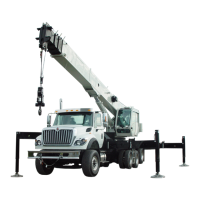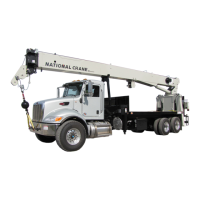National Crane Published 8-01-2017 Control # 287-11 3-1
NBT40 SERVICE MANUAL ELECTRIC SYSTEM
SECTION 3
ELECTRIC SYSTEM
SECTION CONTENTS
Description. . . . . . . . . . . . . . . . . . . . . . . . . . . . . . . . . . 3-1
Maintenance. . . . . . . . . . . . . . . . . . . . . . . . . . . . . . . . . 3-1
General . . . . . . . . . . . . . . . . . . . . . . . . . . . . . . . . . . . 3-1
General Troubleshooting. . . . . . . . . . . . . . . . . . . . . . 3-1
Connector Troubleshooting . . . . . . . . . . . . . . . . . . . . 3-1
Tooling For Troubleshooting . . . . . . . . . . . . . . . . . . . 3-1
Troubleshooting the Electrical Swivel . . . . . . . . . . . . 3-2
Ignition Switch . . . . . . . . . . . . . . . . . . . . . . . . . . . . . . 3-2
RCL system description . . . . . . . . . . . . . . . . . . . . . . . 3-2
RCL & ATB System Description . . . . . . . . . . . . . . . . 3-2
Cab Module, Fuse, Relay Panel . . . . . . . . . . . . . . . . . 3-3
Micro Relay Fuse Box #1 . . . . . . . . . . . . . . . . . . . . . .3-5
Micro Relay Fuse Box #2 . . . . . . . . . . . . . . . . . . . . . .3-5
Micro Relay Fuse Box #3 . . . . . . . . . . . . . . . . . . . . . .3-6
VEC Module . . . . . . . . . . . . . . . . . . . . . . . . . . . . . . . . . .3-7
Crane Manifold Solenoids. . . . . . . . . . . . . . . . . . . . . .3-8
Outrigger manifolds . . . . . . . . . . . . . . . . . . . . . . . . . . .3-9
Front Outrigger Manifold . . . . . . . . . . . . . . . . . . . . . .3-10
Rear Outrigger Manifold . . . . . . . . . . . . . . . . . . . . . .3-10
Hydraulic Oil Cooler . . . . . . . . . . . . . . . . . . . . . . . . . .3-11
Hydraulic Temperature Sensor Warning Light. . . . .3-11
DESCRIPTION
The truck electrical system is a standard 12 volt DC
automotive type and supplies power for all crane functions.
The wire harness is routed through the truck frame and
contains all wiring interface between the truck and the crane
including the electrical outrigger controls.
MAINTENANCE
General
Electrical system maintenance includes troubleshooting and
replacement of damaged components. Observe standard
wiring practices when replacing components.
General Troubleshooting
Make voltage checks at terminations when components are
installed and operating. Make continuity checks when
components are isolated or removed. Trouble shoot per the
following guidelines:
1. Use reported symptoms to identify a problem or a
suspect component.
2. Use a multimeter to test for circuit continuity if you
suspect an open circuit or for voltage if you suspect a
power problem. Check the electrical schematic for the
most accurate wiring information.
3. Replace faulty components and wiring.
4. Test the repaired circuit and verify that the circuit works
properly.
Connector Troubleshooting
The cause of an electrical problem may be a loose or
corroded connection in a connector. Check the connectors to
ensure that the pins and sockets are properly seated and
engaged. If the pins and sockets show any signs of
corrosion, use a good quality electrical contact cleaner or
fine sandpaper to clean them. When the pins or sockets
show signs of arcing or burning, it may be necessary to
replace them.
Damaged connectors need to be cut off the wire and this
may make the wire too short for the new connector to make
proper contact. The wire needs to have some slack after the
connector is put together. Splice a wire of the same size to
the cut wire. Use solder to ensure a good connection and
shrink tube to insulate the splice. Crimp the new connector
on the spliced wire.
Tooling For Troubleshooting
To effectively troubleshoot the electrical system, you need a
Windows-based personal computer, CAN-Link service
software, and a connection cable.
Manitowoc Crane Care requests you have as part of your
service tool kit inventory the CAN-Link service tool kit for the
NBT40. The software will allow you to see in real time the
status of all inputs and outputs on the system, and it will allow
you to detect any errors on input or output. The CAN-Link
DANGER
When metal jewelry, rings, or watches come in contact
with live circuits, serious burns can result. Remove all
metal jewelry, rings, and watches before working on live
circuits.
Reference Only

